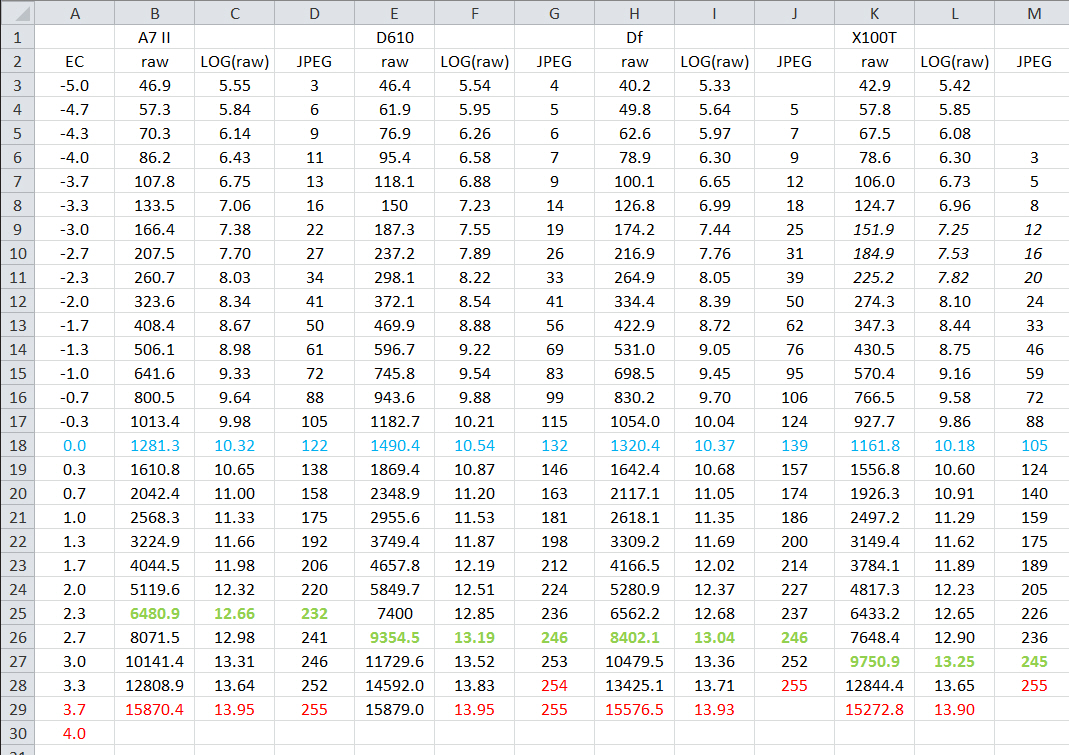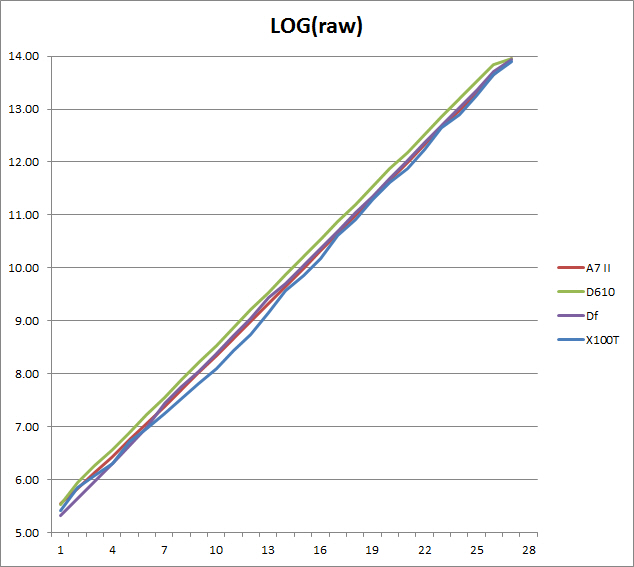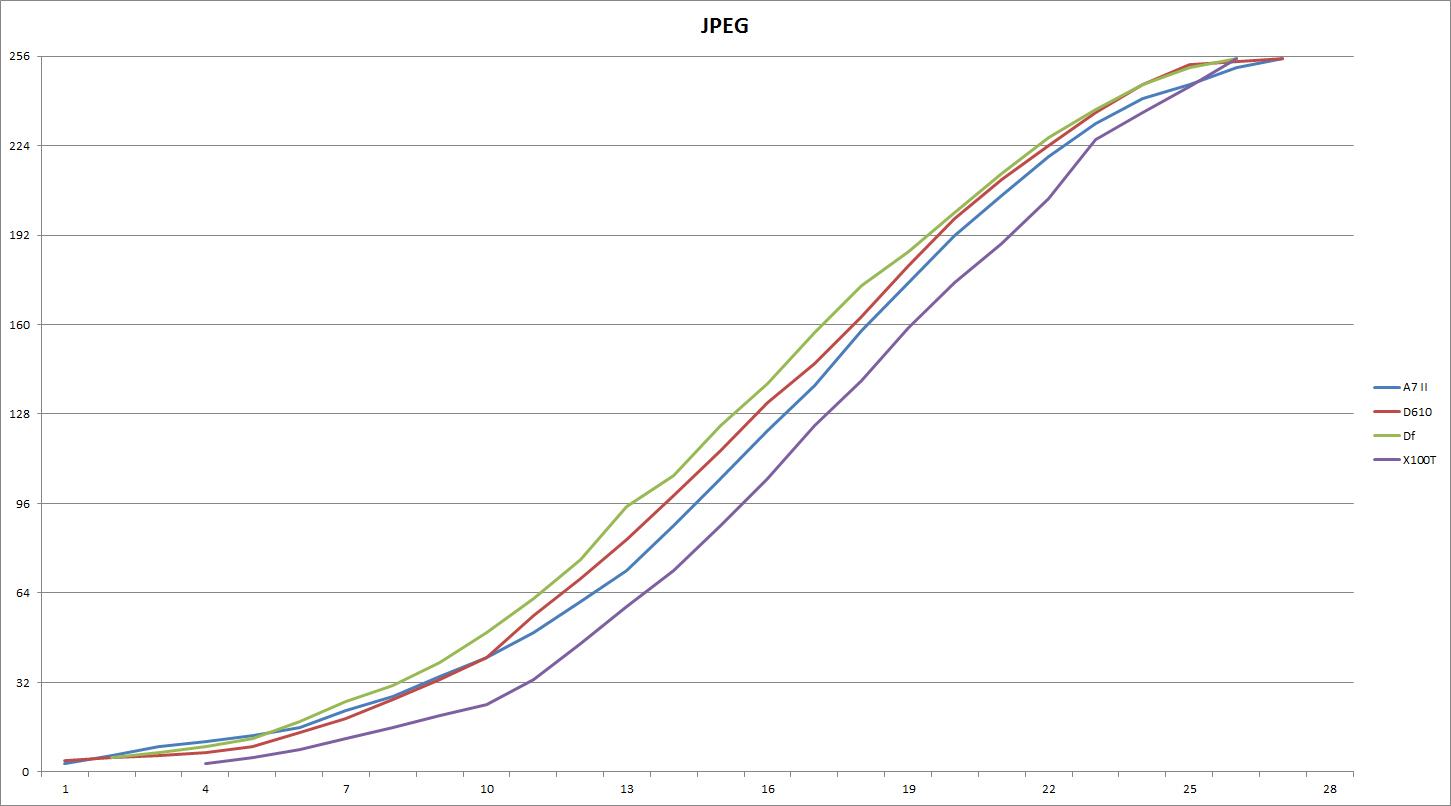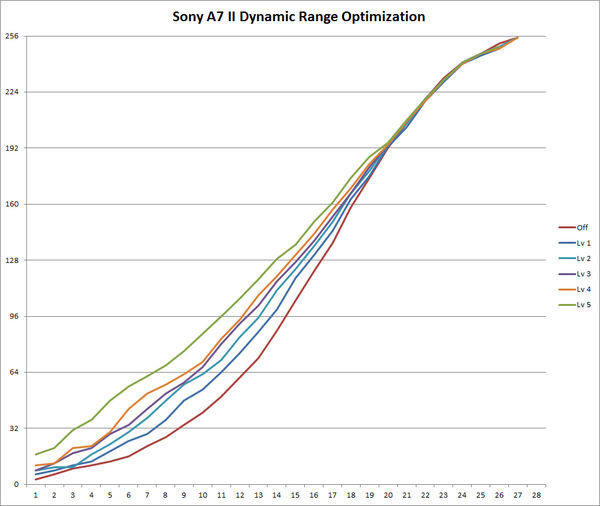Does the JPEG discard highlight information at the high end of the raw file ?
Sep 24, 2019 15:05:44 #
As it turns out, this is an understandable misconception.
As a6k and I realized during a recent discussion on his thread Why do we put middle gray only 3 or 3.3 stops below maximum? (link in next post), the JPEG SOOC does not blow out until the raw file reaches its limit. But the camera's conversion of the raw values starts to lose contrast at the high end (where the JPEG approaches a value of 255). That makes it seem that there is no detail or texture at that level.
To demonstrate this I tested my four cameras over a nine stop range using the following procedure:
1. Set the camera to base ISO and turn off anything that might affect the JPEG values like Active D-Lighting, etc.
2. My target was the white background of an empty Windows Explorer display.
3. I spot metered the target in Manual mode at 1/125 sec to find an aperture that would produce a middle gray with each camera. For example, the D610 with a 50mm f/1.8G at f/2.5 resulted in a meter reading that was neither under or over exposed.
4. I then took a series of 28 images in 1/3 stop increments from 1/4000 sec (5 stops underexposed) to 1/8 sec (4 stop overexposed).
I used RawDigger to tabulate the raw values of the higher of the two Green channels. Although at base ISO the blue and red channels can reach the theoretical maximum of 16383, the green channel never gets that high although two of the cameras get within 0.05 stops. I used PS Elements to measure the JPEG values.
With the D610 I could have used Aperture priority and EC-5 through EC+4 to achieve the same result but the other three cameras do not offer that much range with the exposure compensation dial.
As a6k and I realized during a recent discussion on his thread Why do we put middle gray only 3 or 3.3 stops below maximum? (link in next post), the JPEG SOOC does not blow out until the raw file reaches its limit. But the camera's conversion of the raw values starts to lose contrast at the high end (where the JPEG approaches a value of 255). That makes it seem that there is no detail or texture at that level.
To demonstrate this I tested my four cameras over a nine stop range using the following procedure:
1. Set the camera to base ISO and turn off anything that might affect the JPEG values like Active D-Lighting, etc.
2. My target was the white background of an empty Windows Explorer display.
3. I spot metered the target in Manual mode at 1/125 sec to find an aperture that would produce a middle gray with each camera. For example, the D610 with a 50mm f/1.8G at f/2.5 resulted in a meter reading that was neither under or over exposed.
4. I then took a series of 28 images in 1/3 stop increments from 1/4000 sec (5 stops underexposed) to 1/8 sec (4 stop overexposed).
I used RawDigger to tabulate the raw values of the higher of the two Green channels. Although at base ISO the blue and red channels can reach the theoretical maximum of 16383, the green channel never gets that high although two of the cameras get within 0.05 stops. I used PS Elements to measure the JPEG values.
With the D610 I could have used Aperture priority and EC-5 through EC+4 to achieve the same result but the other three cameras do not offer that much range with the exposure compensation dial.
Sep 24, 2019 15:05:58 #
Here is the link to a6k's Why do we put middle gray only 3 or 3.3 stops below maximum?
The table of values for the four cameras:

The blue row (16) is the base exposure for middle gray. The average JPEG value for the base exposure from all four cameras is about 124. All of the cameras are within +/-0.3 stops of this average.
The green row shows the last exposure that did not result in any highlight warnings or zebra stripes. The Sony gives 1/3 stop more warning than the Nikons and the Fuji one stop less.
The red row is where the raw file or the JPEG reaches the highest possible value before blowing out the highlights. For two of the cameras, the raw and JPEG reach the maximum at the same time and for the other two the raw file provides only 1/3 stop of additional exposure.
I removed some of the values at the top or bottom of the ranges where the values stopped changing.
This plot shows that the raw file produces a virtually straight response between the extreme values for all three cameras:

And finally, the resulting JPEG SOOC values show how the JPEG reaches the limits of the useful raw range by reducing the contrast in the upper and lower ranges:

Even though the four cameras produce images with slightly different mid-tone brightness SOOC, the contrasts are nearly identical throughout their ranges.
All but one of the cameras record differences in the raw data and in the JPEG up to 3.3 stops beyond the midpoint and the Df reaches 3.0 stops. That was the basis for a6k's question.
The table of values for the four cameras:

The blue row (16) is the base exposure for middle gray. The average JPEG value for the base exposure from all four cameras is about 124. All of the cameras are within +/-0.3 stops of this average.
The green row shows the last exposure that did not result in any highlight warnings or zebra stripes. The Sony gives 1/3 stop more warning than the Nikons and the Fuji one stop less.
The red row is where the raw file or the JPEG reaches the highest possible value before blowing out the highlights. For two of the cameras, the raw and JPEG reach the maximum at the same time and for the other two the raw file provides only 1/3 stop of additional exposure.
I removed some of the values at the top or bottom of the ranges where the values stopped changing.
This plot shows that the raw file produces a virtually straight response between the extreme values for all three cameras:

And finally, the resulting JPEG SOOC values show how the JPEG reaches the limits of the useful raw range by reducing the contrast in the upper and lower ranges:

Even though the four cameras produce images with slightly different mid-tone brightness SOOC, the contrasts are nearly identical throughout their ranges.
All but one of the cameras record differences in the raw data and in the JPEG up to 3.3 stops beyond the midpoint and the Df reaches 3.0 stops. That was the basis for a6k's question.
Sep 24, 2019 15:44:14 #
More importantly, does the little light in the refrigerator really turn off when you shut the door? I worry about whether the photo I shot today is better than one I shot two days ago. I’m sorry brother “selmslie” - not making light of your serious concepts - but I’m not into quantum theory, I just shoot images as a hobby.
Sep 24, 2019 15:54:33 #
Sep 24, 2019 15:57:07 #
rjaywallace wrote:
More importantly, does the little light in the refrigerator really turn off when you shut the door? I worry about whether the photo I shot today is better than one I shot two days ago. I’m sorry brother “selmslie” - not making light of your serious concepts - but I’m not into quantum theory, I just shoot images as a hobby.
Most of us can do very well without getting into the details.
But we have seen a lot of claims about exposure and ETTR based observation of images and opinions without rigorous testing to back them up.
Sep 24, 2019 16:06:34 #
BebuLamar wrote:
Thanks Scotty. But now I am wondering why the JPEG curves don't conform to gamma 2.2.
I think that gamma refers to the slope of the JPEG in the middle zones - between JPEG 32 and 224.
If you look outside that range the curve necessarily bends to reach the end points.
Here is another example. Note that with a higher level of DRO the slope is reduced and the line becomes straighter.
The red line on the bottom is with DRO off.
Sep 24, 2019 19:33:40 #
a6k
Loc: Detroit & Sanibel
This is excellent, solid, empirical work. I intend to look at it a lot more so this is just a "thank you".
Notwithstanding the usual crew who immediately offer the important news that they just go out and take pictures, I am more convinced than ever that the the more we understand what the sensor does (in creating a raw file) the more we can effectively use the post processor program (app). Or stated another way, understanding how to get the result (output) that you want must to some extent depend upon knowledge of the starting point (input).
I freely admit to being very uninformed on this and also to being somewhat math challenged. But I do value and enjoy the conversations like this on UHH.
Notwithstanding the usual crew who immediately offer the important news that they just go out and take pictures, I am more convinced than ever that the the more we understand what the sensor does (in creating a raw file) the more we can effectively use the post processor program (app). Or stated another way, understanding how to get the result (output) that you want must to some extent depend upon knowledge of the starting point (input).
I freely admit to being very uninformed on this and also to being somewhat math challenged. But I do value and enjoy the conversations like this on UHH.
Sep 24, 2019 19:37:51 #
a6k
Loc: Detroit & Sanibel
rjaywallace wrote:
More importantly, does the little light in the refrigerator really turn off when you shut the door? I worry about whether the photo I shot today is better than one I shot two days ago. I’m sorry brother “selmslie” - not making light of your serious concepts - but I’m not into quantum theory, I just shoot images as a hobby.
My impression of professional photographers is that many or even most ignore all this technology and do what they do best: Compose, expose, print and above all else, please the clients.
I'd bet, sans any actual data, that it's the hobbyists that obsess over this stuff (and, of course, the engineers at Sony, Nikon, Canon, Fuji etc.)
I count myself as a hobbyist, too. And yes, the little light does go off, I cheated and found the little switch.
Sep 25, 2019 04:56:43 #
a6k wrote:
My impression of professional photographers is that many or even most ignore all this technology and do what they do best: Compose, expose, print and above all else, please the clients. ...
That has always been the case and with good reason. Very few photographers are scientific in their approach and careful testing can be tedious. It's a lot easier to sit at the computer and look for answers on the internet.
But there are many questions that can be easily answered by picking up a camera and aiming it at a reliable target.
Sep 25, 2019 07:42:19 #
One of my photography instructors once told us about two very different photographers he once knew. The first one, educated as an engineer, was painstaking precise in his photography, planned every step, every setting, using precise measurements and a detailed process to shoot his photos. He had studied and educated himself about the physics of photography and had even written a few papers in technical journals about technical or industrial photography techniques.
The second one was an artist by training and shot entirely by intuition and how the scene "felt" to him. He knew very little about the technical aspects of photography and had little desire to know any more than he had to about the camera's technical operations. To him, photography was all about composition and his interpretation of what the scene was trying to express.
Both were successful and produced great images.
The second one was an artist by training and shot entirely by intuition and how the scene "felt" to him. He knew very little about the technical aspects of photography and had little desire to know any more than he had to about the camera's technical operations. To him, photography was all about composition and his interpretation of what the scene was trying to express.
Both were successful and produced great images.
Sep 25, 2019 11:48:16 #
selmslie wrote:
As it turns out, this is an understandable misconc... (show quote)
Well, that's a (duh), as everybody knows there is no detail at 255. That's a given, no testing needed!
Sep 25, 2019 12:03:05 #
a6k wrote:
This is excellent, solid, empirical work. I intend... (show quote)
👍👍 yep - no engineers=no cameras.
Sep 25, 2019 12:06:57 #
selmslie wrote:
That has always been the case and with good reason. Very few photographers are scientific in their approach and careful testing can be tedious. It's a lot easier to sit at the computer and look for answers on the internet...
Agreed. A read of Ansel Adam’s books will show that he was very much the “technician” as well as the artist, and it worked out pretty well for him.
Sep 25, 2019 12:24:26 #
rjaywallace wrote:
More importantly, does the little light in the refrigerator really turn off when you shut the door? I worry about whether the photo I shot today is better than one I shot two days ago. I’m sorry brother “selmslie” - not making light of your serious concepts - but I’m not into quantum theory, I just shoot images as a hobby.
Jumping Jingling Cheesus, yes! All of those facts and figures make my pretty little head hurt. Who cares!? I don't need to know the exact pounds of pressure per square centimeter per cylinder in my internal combustion engine. I just need to know that I enjoy driving my car. Wow. I wish I had this much free time!
Sep 25, 2019 12:40:34 #
sbohne wrote:
Jumping Jingling Cheesus, yes! All of those facts and figures make my pretty little head hurt. Who cares!? I don't need to know the exact pounds of pressure per square centimeter per cylinder in my internal combustion engine. I just need to know that I enjoy driving my car. Wow. I wish I had this much free time!
Yes, there are much bigger fish to fry

If you want to reply, then register here. Registration is free and your account is created instantly, so you can post right away.





